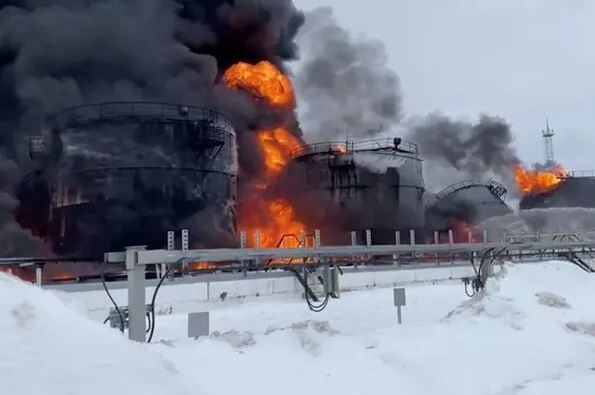
Ukraine struck with a drone attack on an oil depot in Russia on Friday, officials on both sides said, the latest in a series of recent attacks targeting Russian oil facilities as Kiev increasingly seeks to hit critical infrastructure behind Russian lines, The New York Times reported. Monday.
Alexander Bogomaz, the governor of Russia’s Bryansk region, which borders Ukraine, said oil tanks in the city of Klintsy caught fire after a drone dropped ammunition on the depot. He added that the drone was brought down by electronic interference. A Ukrainian intelligence official, speaking on condition of anonymity to discuss sensitive military matters, said Ukraine was behind the attack.
Friday’s attack was the fourth attack on Russian oil facilities in three weeks in what experts say is Ukraine’s attempt to reverse Russia’s military capabilities by targeting facilities that fuel tanks, fighter jets and other critical military equipment.
“Attacks on oil depots and oil depots disrupt logistics routes and slow down combat operations,” said Olena Lapenko, an energy security expert at the DiXi Group, a Ukrainian think tank. “Disrupting these supplies, which are like blood to the human body, is part of a broader strategy to fight Russia on the battlefield.”
These attacks are unlikely to have a major impact on the overall posture of the fighting in which Russia has gone on the offensive in the past few months. But they remain important to Ukraine, which has been looking for ways to wreak havoc far from the largely gridlocked front line. Without sufficient weapons and troops to regain the initiative on the ground, Kiev is increasingly turning to guerrilla tactics to disrupt Russian operations, including sabotage activities against rail infrastructure and ammunition depots.
Oleksandr Kamyshin, Ukraine’s minister for strategic industry, said on Thursday that an “asymmetric war” was underway. He claimed responsibility for Thursday’s attack on an oil storage facility in St. Petersburg, which he said involved a home-made drone that flew 1,250 kilometers, or about 775 miles.
Although the attack in St. Petersburg did not appear to cause serious damage, images of the Klintsy oil depot showed a large fire raging between several tanks. Russia’s state-run TASS news agency said the fire covered an area of about 1,000 square meters, or about 10,700 square feet, and that four gasoline tanks were on fire.
Also read: India has no proof Balakot strike was a success: Ex-Indian envoy
Mr. Bogomaz, the Russian governor, said in a post on social media that more than 140 firefighters were trying to put out the fire. He posted a video showing them spraying water on the blackened oil tanks, which were billowing huge plumes of black smoke.
Energy infrastructure was the main theater of war. Last winter, Russia struck Ukraine’s energy facilities with drones and missiles, plunging Ukrainians into cold and darkness, in what was seen as Moscow’s attempt to weaponize winter and demoralize the population. Ukraine managed to survive the attacks thanks to Western-supplied air defense systems and the round-the-clock work of engineers to repair vital equipment.
Ukraine has targeted Russian oil and gas infrastructure on a smaller scale since the start of the conflict. However, the recent spate of attacks may indicate that energy infrastructure has now become a critical target for Kyiv.
Two other drone strikes, on December 29 and January 9, resulted in fires at a refinery in southwestern Russia’s Krasnodar and at a fuel facility in Oryol, a town near Klintsy. In both cases, the Ukrainian military claimed responsibility in the Ukrainian news media.








